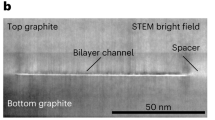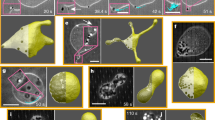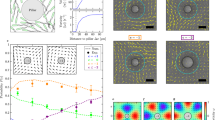Abstract
The brownian motion of mesoscopic particles is ubiquitous and usually random. But in systems with periodic asymmetric barriers to movement, directed or ‘rectified’ motion can arise and may even modulate some biological processes1. In man-made devices, brownian ratchets and variants based on optical or quantum effects have been exploited to induce directed motion2,3,4,5,6,7,8,9,10,11,12,13,14, and the dependence of the amplitude of motion on particle size has led to the size-dependent separation of biomolecules6,8,15. Here we demonstrate that the one-dimensional pores of a macroporous silicon membrane16, etched to exhibit a periodic asymmetric variation in pore diameter, can act as massively parallel and multiply stacked brownian ratchets that are potentially suitable for large-scale particle separations. We show that applying a periodic pressure profile with a mean value of zero to a basin separated by such a membrane induces a periodic flow of water and suspended particles through the pores, resulting in a net motion of the particles from one side of the membrane to the other without moving the liquid itself. We find that the experimentally observed pressure dependence of the particle transport, including an inversion of the transport direction, agrees with calculations17,18 of the transport properties in the type of ratchet devices used here.
This is a preview of subscription content, access via your institution
Access options
Subscribe to this journal
Receive 51 print issues and online access
$199.00 per year
only $3.90 per issue
Buy this article
- Purchase on Springer Link
- Instant access to full article PDF
Prices may be subject to local taxes which are calculated during checkout




Similar content being viewed by others
References
Huxley, A. F. Muscle structure and theories of contraction. Prog. Biophys. Biophys. Chem. 7, 255–318 (1957)
von Smoluchowski, M. Experimentell nachweisbare, der üblichen Thermodynamik widersprechende Molekularphänomene. Phys. Zeitsch. 13, 1069–1080 (1912)
Feynman, R. P., Leighton, R. B. & Sands, M. The Feynman Lectures On Physics Ch. 46 Vol. 1 (Addison-Wesley, Reading, Massachusetts, 1966)
Faucheux, L. P., Bourdieu, L. S., Kaplan, P. D. & Libchaber, A. J. Optical thermal ratchet. Phys. Rev. Lett. 74, 1504–1507 (1995)
Marquet, C., Buguin, A., Talini, L. & Silberzan, P. Rectified motion of colloids in asymmetrically structured channels. Phys. Rev. Lett. 88, 168301 (2002)
Derényi, I. & Astumian, R. D. AC separation of particles by biased Brownian motion in a two-dimensional sieve. Phys. Rev. E 58, 7781–7784 (1998)
Rousselet, J., Salome, L., Ajdari, A. & Prost, J. Directional motion of brownian particles induced by a periodic asymmetric potential. Nature 370, 446–448 (1994)
van Oudenaarden, A. & Boxer, S. G. Brownian ratchet: molecular separations in liquid bilayers supported on patterned arrays. Science 285, 1046–1048 (1999)
Linke, H. et al. Experimental tunneling ratchets. Science 286, 2314–2317 (1999)
Switkes, M., Marcus, C. M., Campman, K. & Gossard, A. C. An adiabatic quantum electron pump. Science 283, 1905–1908 (1999)
Hänggi, P. & Bartussek, R. Lecture Notes in Physics Vol. 476 (eds Parisi, J., Müller, S. C. & Zimmermann, W.) 294–308 (Springer, Berlin, 1996)
Astumian, R. D. Thermodynamics and kinetics of a brownian motor. Science 276, 917–922 (1997)
Astumian, R. D. & Hänggi, P. Brownian motors. Phys. Today 55(11), 33–39 (2002)
Linke, H. (ed.) Ratchets and Brownian motors: basics, experiments and applications. Appl. Phys. A (Special Issue) 75(2), (2002)
Cabodi, M., Chen, Y.-F., Turner, S. W. P., Craighead, H. G. & Austin, R. H. Continuous separation of biomolecules by the laterally asymmetric diffusion array with out-of-plane sample injection. Electrophoresis 23, 3496–3503 (2002)
Müller, F. et al. Membranes for micropumps from macroporous silicon. Phys. Stat. Sol. A 182, 585–590 (2000)
Kettner, C., Reimann, P., Hänggi, P. & Müller, F. Drift ratchet. Phys. Rev. E 61, 312–323 (2000)
Kettner, C., Hänggi, P. & Müller, F. Verfahren und Vorrichtung zur größenabhängigen Sortierung mikroskopisch kleiner Teilchen auf der Basis von rauschinduziertem Transport. German patent pending (DE 199 07 564 A 1), submitted 22 Feb. 1999.
Lehmann, V. & Föll, H. Formation mechanism and properties of electrochemically etched trenches in n-type silicon. J. Electrochem. Soc. 137, 653–659 (1990)
Lehmann, V. The physics of macropore formation in low doped n-type silicon. J. Electrochem. Soc. 140, 2836–2843 (1993)
Schilling, J. et al. 3D photonic crystals made out of macroporous silicon by modulation of pore diameter. Appl. Phys. Lett. 78, 1180–1182 (2001)
Lehmann, V. & Grüning, U. The limits of macropore array fabrication. Thin Solid Films 297, 13–17 (1997)
Tong, Q. Y. & Gösele, U. Semiconductor Wafer Bonding 53–54 (Wiley and Sons, New York, 1999)
Acknowledgements
We thank U. Gösele for backing the ratchet project over many years. We also gratefully acknowledge discussions on the theory of the ratchet-effect with P. Hänggi, Ch. Kettner, P. Reimann and R. Eichhorn as well as critical reading of the manuscript by K. Scheerschmidt and R. B. Wehrspohn.
Author information
Authors and Affiliations
Corresponding author
Ethics declarations
Competing interests
The authors declare that they have no competing financial interests.
Supplementary information
Rights and permissions
About this article
Cite this article
Matthias, S., Müller, F. Asymmetric pores in a silicon membrane acting as massively parallel brownian ratchets. Nature 424, 53–57 (2003). https://doi.org/10.1038/nature01736
Received:
Accepted:
Issue Date:
DOI: https://doi.org/10.1038/nature01736
This article is cited by
-
Simultaneous and independent topological control of identical microparticles in non-periodic energy landscapes
Nature Communications (2023)
-
Overcrowding induces fast colloidal solitons in a slowly rotating potential landscape
Nature Communications (2023)
-
Multiple current reversals and negative differential mobility induced by a periodic kick force
Indian Journal of Physics (2023)
-
Glucose oxidase immobilized macro porous silicon based conductive glucose sensor
Applied Physics A (2022)
-
Selective Transport of Airborne Microparticles Through Micro-channels Under Microgravity
Microgravity Science and Technology (2021)
Comments
By submitting a comment you agree to abide by our Terms and Community Guidelines. If you find something abusive or that does not comply with our terms or guidelines please flag it as inappropriate.



